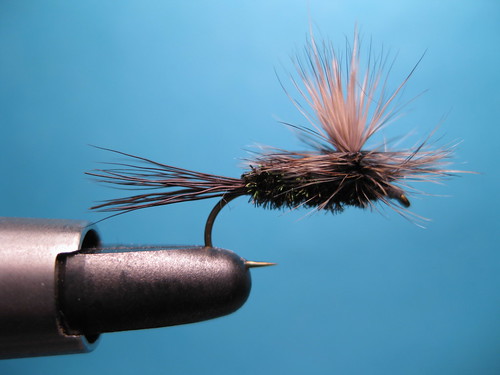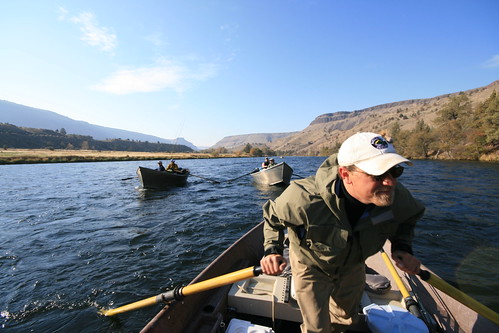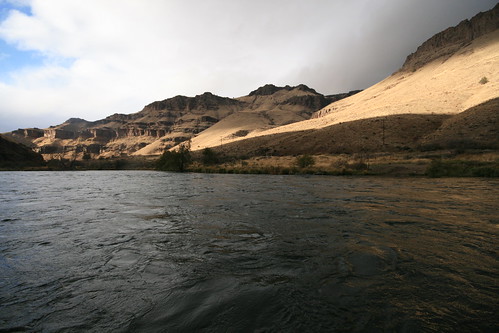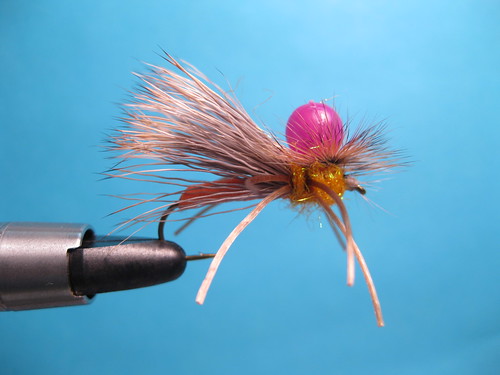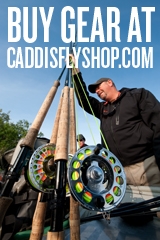This is the seventh installment of The Fly Fishers Glossary: Snippets From the Underbelly of Fly Fishing, Fly Tying, Fish Biology, Dusty old Facts, Hallucinations, and the Plain Truth as I know it, by Jay Nicholas.
Dollie
Formerly, a Dollie (sometimes Dolly) was an undesirable but rare trash fish detested because they gobbled up hatchery trout on the Metolius. Now, these have been taxonomically reclassified as Bull Trout, the non-anadromous form of this species of char. As neither salmon or steelhead, this is still a undesirable fish. However, the large size of Bull Trout in the Metolius makes them a target for ego-driven individuals who fish for them selectively with twenty-two inch bunny Leeches and 8/0 hooks. A twenty-pound Bull Trout fights for about three seconds and then lays there like a burlap sack.
Double Haul
The practice of buying so much stuff at the Caddis Fly that it takes two trips from the truck to the house where one hides the stuff before one’s wife/girlfriend gets home. Thus, “I made a double haul at the Caddis Fly today”.
Alternate
The practice of stacking or nesting two drift or more boats on one trailer to haul over to the Deschutes in order to save gas. See also, cost of replacing transmission, ruptured vertebrae, and warped brake calipers.
Alternate
Running a double drift from Cedar Creek to Memaloose twice in one day. Rob, you ‘da man.
Dr. Slick
Talk about slick. This is a brand of fly tying and fly fishing tools that is a fine example of marketing genius. Back in the old days, we had a pair of scissors, and maybe a pair of pliers. Not now. No sirree. Thanks to geniuses like Dr. Slick we have at least a hundred different types of fly tying scissors. Then there are the pliers, hemostats scissor-hemostats, de-barb Pliers/cutters, S-side clamp/cutter, and surgical steel tools. Egads, no wonder I buy so dang much stuff. The choices never end, and there is always an option to upgrade at the dawn of each new season.
Drift Boat
A device designed to occupy space in a garage, excluding any possibility of parking a car in its proper place. Also, a cause of premature deterioration of rubber seals, blistered paint, and pervasive rust inflicted on fifty-thousand dollar SUVs that are constantly exposed to the weather as a consequence of being parked outside the garage. Drift boats are most commonly used to store broken lawnmowers, junk that should have been thrown away eight years ago, toxic yard chemicals, and refrigerator-sized cardboard boxes that might prove useful sometime in the next decade.
 Photo: Wooden Boat People
Photo: Wooden Boat People
Drive-by
This is a term means that an angler felt a Salmon rub his line or leader. See also line-rub. Drive-bys are very exciting to salmon anglers because it indicates that a) salmon are present and b) their lines are at the correct depth.
Unfortunately, Pogies are skilled in the art of simulating the genuine drive-by and drive-bys are also exactly like the feeling created by hooking a beaver stick, otter, water ouzel, bald eagle, or underwater volcano.
The most crafty salmon fishers are loathe to divulge that they have had drive-bys, even when they are so forceful as to have nearly jerked their arms out of their sockets. These sly dogs keep their eyes on the rod tips, often submerging the tip a few inches underwater so as to obfuscate drive-by detection. As skilled as a drive-by recipient may be at concealing their emotional response via body language, their pupils ALWAYS dilate, indicating a heightened response to the drive-by. This is what every experienced angler in the hog line is trying to detect.
Dry fly
This is a nonsensical term applied to a fly that is intended to stay “Dry” and float on the surface of the water, thus imitating a mature insect. Any fly fisher knows that this is not the way flies behave. First and foremost, a fly can only stay dry just so long as the angler does not cast it upon the waters, at which time it becomes wet, and therefore, not a dry fly. Second, it is common knowledge that all commercially tied “Dry flies” are constructed with materials like tungsten, titanium, and lead boat anchors, thereby limiting the amount of time the fly will stay on the water’s surface to about three microseconds. “Wet flies”, in contrast, are typically tied with water-repellant materials and balsa wood hooks, thereby making them extremely difficult to submerge beneath the water’s surface. Both of these fly construction practices are another ploy to sell more gizmos to the fly angler consumer. Specifically, all sorts of fly poo is marketed with claims that it will either float or sink the consumer’s fly, depending on said angler’s wishes. In practice, however, the product usually leaks into the angler’s pockets, making an unattractive stain that usually corresponds with said angler’s crotch, implying peeing in one’s pants. These fly poo mixtures are basically a derivative of bacon grease, scented with Old Spice and English Leather aftershave.
Dumbbell eyes
The look on the face of any fly angler as he or she walks through the door of their independently owned fly shop. Dumbbell eyes: that’s the only way to describe it folks. They find themselves surrounded by the most marvelous and innovative products and fly tying materials imaginable. There is tackle designed specifically for every species of fish in the world. There are gizmos, price-point rods, and all the latest and greatest doo-dads that we simply must have to live.
Alternate
Dumbell or hourglass eyes are a fly tying product lashed onto a fly hook and intended to create the illusion of eyes on some sort of fish food. Dumbell eyes could be made of brass, nickel, aluminum, bead chain, plastic, titanium, lead, or depleted uranium retrieved from Iraqi WMDs. The use of different materials and sizes has something complicated to do with sink rates. Predatory fish, purportedly, bite flies with dumbbell eyes more frequently than flies without, because the eyes trigger their natural feeding instinct. Apparently, predaceous fish eat fish eyes. Some fly tyers claim that bigger eyes trigger more bites from bigger fish. This claim has led to marketing of dumbbell eyes about the size of a two bowling balls. Ridiculous, but true.
Eagle Claw Fly Hooks
Obsolete fly tying material. For steelhead and Sea-run Cutthroat flies, the Eagle Claw #3906 hook was more commonly used than the Mustad #36890. These #3906s were down-eye, heavy-wire sproat-bend hooks that a bizilion flies were dressed on for decades. The hooks were produced in bronze (3906-B), nickel (3906-N) and gold (3906-G). Less expensive than the up-eye, Japan-black Mustad steelhead/salmon hook, these babies were our go-to hooks.
e-Bay
Internet-based site that provides an opportunity for unscrupulous people to sell crappy junk (i.e., tackle that they hated and will never use).
Alternate
A place to get a great deal on tackle you’ll hate, because it isn’t what you need like for example a two-piece, 18’, 10-wt, Loomis Spey rod. Note; cheap-ass fly fisher’s buy stuff on e-bay and then try to get local-area Fly Shops to teach them how to use it or obtain warranty service when the product doesn’t work.
Alternate
E-bay provides an opportunity for wives/girlfriends to sell a fly fisher’s stuff during an extended absence on a fishing trip. Our women have figured out that three, $900 Spey rods will finance one pedicure, a Grande-half decaff-skinny-caramel-with-whipped-Macchiato, and a month subscription to an on-line dating service. See also Craigslist.
Eagle Claw Fly Rod
Obsolete Fly Fishing Product. These fly rods were invented by Aliens over ten Millennia ago and first used to fly fish the Nile River in Egypt. Eagle Claw Fly rods reigned supreme until the mid 1970s when the Fenwick Feralite fly Rod was introduced to provide a technological bridge to the thousand-dollar junk rods we fish today.
Elephant Clippers
These are actually a special variation on nippers, but this pure is marketing genius deserves special notice. Not satisfied with naming a pair of nippers something ordinary and expected like super jumbo nippers, the clever marketer coined this reference to elephants. Wow, who can possibly resist buying a dozen of these beauties? Warning: do not, under any circumstances whatsoever, attempt to clip an elephant’s anything with these clippers. Not smart.
Elmer Fudd Hat
One of the dorkiest hats ever designed by Simms. That said, I bought this winter hat and love it! It is waterproof, has a bill to keep sun out of my eyes, flaps keep ears warm, and I am a dork anyway so who cares?
-JN

